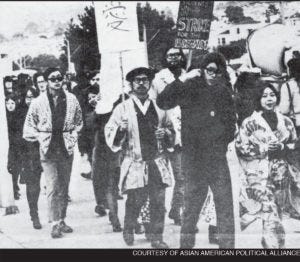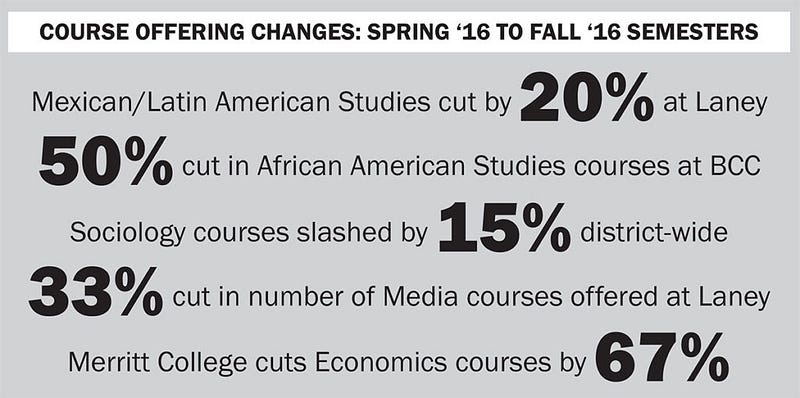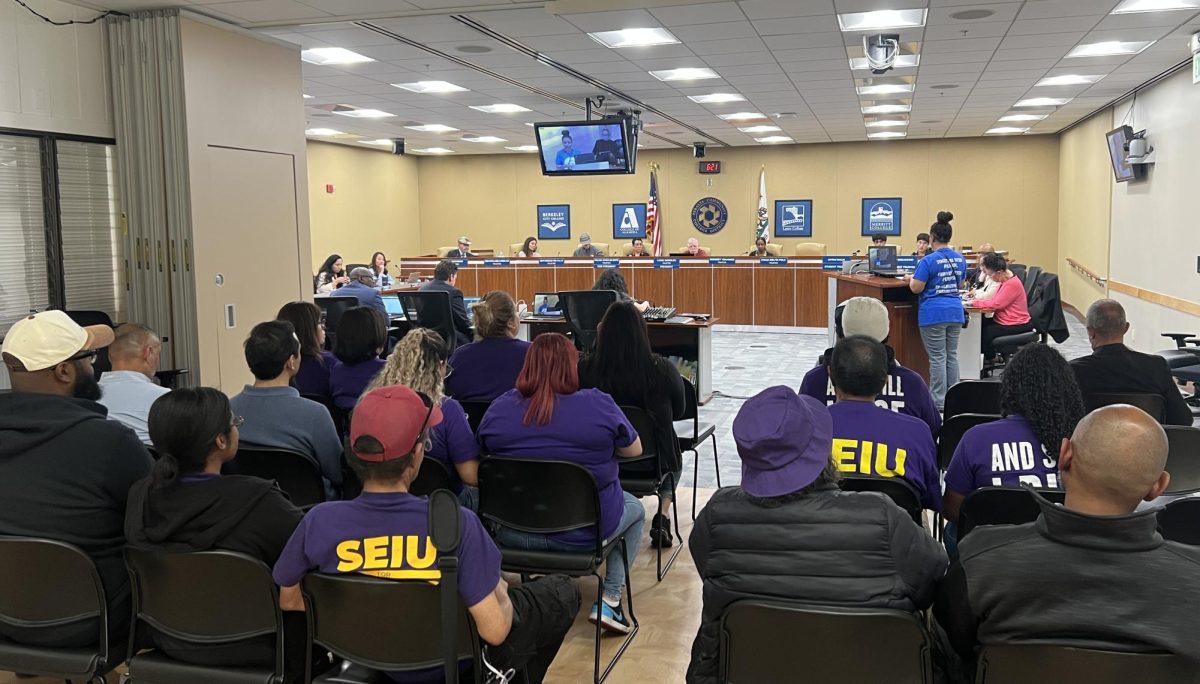SAVE ETHNIC STUDIES: A two-part series on the fifty-year struggle for the soul of higher education

The Peralta College District is facing a major drop in enrollment, and because of that a major drop in funding.
Underperforming classes are being targeted district-wide. Certain departments, especially small ones and those in the social sciences, are being hit much harder than others.
Across the district, 33 percent of Asian American Studies classes are being cut as well as 14.7 percent of Sociology classes and almost 11 percent of Communication courses.
Laney, because it has the largest enrollment of any of the four Peralta Colleges, has the largest number of cuts. It is losing more than 73 percent of its sociology classes, one third of its classes in media, humanities and Asian American Studies, one fourth of its Philosophy classes and one fifth of its Mexican/Latin American Studies classes.
Other departments hit hard include African American Studies at Berkeley City College (50 percent), Economics (67 percent), Kinesiology (61 percent) and Asian American Studies (50 percent) at Merritt College.
DATA COLLECTION
Paradoxically, however, the district has actually added classes overall, across departments.
This semester, the district offered 2,512 classes. For the Fall 2016 semester, it is scheduled to offer 2,617 classes.
These figures represent what is planned. They are subject to change and there will almost certainly be more classes cut for low enrollment.
Three of the Peralta Colleges (Berkeley City College, College of Alameda, and Merritt College) provided exact data to the Tower.
Laney College declined to follow suit.
Laney’s Vice President of Instruction Lilia Celhay said the numbers “weren’t ready yet,” so Tower staff members used Laney’s Passport website, to compare the number of classes Laney offered this semester (Spring 2016) with the number being offered for Fall 2016.
Since the offerings on Passport may not reflect the most up-to-date information, it is likely that the data presented reflect a conservative estimate of the cuts that will ultimately be made.
HOW CLASSES GET CUT
“We’re less likely to cut classes that are full, but if we see a class that is half-full, that makes it vulnerable,” Celhay said.
The district is targeting classes that are important and have an impact on student success and empowerment whether they are full or not. She made several suggestions for ways students could keep classes from being cut.
She encouraged students to enroll for classes as soon as possible. She also recommended students “Take a full load,” to help the administration understand what classes students want.
She urged students to get involved saying, “I would encourage students to become active participants in our shared governance…It enriches the conversations.” Students do need to take an active role in their education and stand up for the things that are important to them.

ETHNIC STUDIES
The problem is that students, especially those attending community colleges, don’t always know what classes are going to be important until it’s too late.
The problem is made worse because Ethnic Studies, and its sub-departments such as Asian American Studies and African American Studies, are already characterized as non-essential.
This is despite the fact that many believe the discipline empowers students. (See pages 1 and 4 for our coverage on the battle at SF State to preserve and support the Ethnic Studies programs.)
Kei Fischer, an Ethnic Studies instructor both at SFSU and Laney, explains that many community college students come from marginalized communities or communities under-represented in higher education.
“Ethnic Studies is seen as a gateway of success and accessibility of education for different diverse communities,” Fischer said.
She goes on to say that Ethnic Studies shines a light on the contributions of often overlooked communities.
“When you go to a class and are told you don’t matter — none of your people were president or leaders- you are going to internalize that and think school really isn’t for you,” she said. “Ethnic Studies flips the focus to what students bring into the classroom.”
Fischer cited a recent study conducted by Stanford University that found when Ethnic Studies were introduced to high schools, students did better in all their other classes, such as math and science.
When asked why it was important to have Ethnic Studies classes, even if they weren’t as full as some other classes, she responded, “It helps students understand the world that we live in. It helps them build empathy and deep meaningful relationships, and that an important and valuable skill in any field. On top of that it’s about creating a better society for all different people.
UNDERPRIORITIZED
Fischer and other anonymous faculty sources believe that the reason some of their courses may be under-enrolled is that students don’t recognize the number of ways their courses can be used to fulfill transfer requirements. Students tend to concentrate on only required courses.
Fischer said, “If there are only 15 students in an Ethnic Studies class it doesn’t mean it’s less valuable than an English or math class, for example.”
Isn’t keeping classes that affect the lives of students and inspire them to continue on with their education even when times get hard more important than making sure all a campus’ classes are fully enrolled?
One faculty member upon hearing about the upcoming class cuts wondered why Laney hadn’t considered cutting back on classes in the summer semester rather than classes in the fall.
The teacher who wished to remain anonymous said, “I think less students would be impacted by cutting summer classes. It’s been my experience that when somebody has to leave campus to get a class somewhere else, we lose a student.”
“Having the classes that are needed to transfer or complete a certificate program available to students is also important. If students are faced with obstacles like not being able to finish a program because classes are unavailable they are more likely to give up on their education,” the instructor added.
VICIOUS CYCLE
With enrollment numbers already dropping, it seems like cutting classes will only lower the number of students across the district.
One student at Laney, who preferred to remain anonymous, reported that she had tried to take the same course for three consecutive semesters but was unable to because each time the course was cancelled for low enrollment. She added that she would try one more time before giving up.
The administration understands that is importance of offering the classes that students need.
Celhay admits that enrollment management in complicated.
“You want to take into account student enrollment, courses needed for completion, student success and our faculty,” she said.
“You look at how what you are doing now is going to affect the future… it’s not an easy endeavor to take on.”
Hopefully, solutions to these perplexing problems will be found. Finding them may require “thinking outside the box.”
For one potential solution, read Chris Stroffolino’s editorial titled, ‘SMALL CLASSES: The solution, not the problem.’
An administrator’s guide to keeping your classes from being cut
Laney College’s Vice President of Instruction Lilia Celhay offers students advice
- Enroll as soon as possible
Log on to the Passport website as soon as enrollment begins and sign up for the courses you want. - Take as many classes as possible
“Take a full load,” Celhay suggested, in order to help the administration understand what students want. - Participate in shared governance
Celhay urges students to get involved and “become active participants… it enriches the conversation.”

























